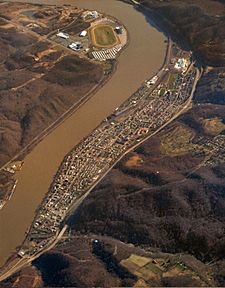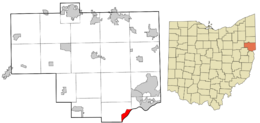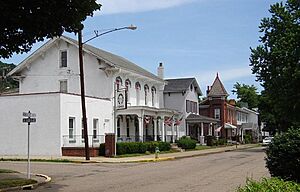Wellsville, Ohio facts for kids
Quick facts for kids
Wellsville, Ohio
|
|
|---|---|
|
Village
|
|

Wellsville from the air, looking south. The Mountaineer Casino, Racetrack and Resort is visible towards the top.
|
|

Location of Wellsville in Columbiana County, Ohio.
|
|
| Country | United States |
| State | Ohio |
| County | Columbiana |
| Government | |
| • Type | Council–manager |
| Area | |
| • Total | 1.91 sq mi (4.95 km2) |
| • Land | 1.80 sq mi (4.67 km2) |
| • Water | 0.11 sq mi (0.28 km2) |
| Elevation | 715 ft (218 m) |
| Population
(2020)
|
|
| • Total | 3,113 |
| • Density | 1,727.52/sq mi (667.02/km2) |
| Time zone | UTC-5 (Eastern (EST)) |
| • Summer (DST) | UTC-4 (EDT) |
| ZIP code |
43968
|
| Area code(s) | 330, 234 |
| FIPS code | 39-82740 |
| GNIS feature ID | 1085906 |
| School district | Wellsville Local School District |
Wellsville is a small village located in Columbiana County, Ohio, in the United States. In 2020, about 3,113 people lived there.
Long ago, Wellsville was an important place for shipping goods. This happened thanks to the Ohio River and the Pennsylvania Railroad. The village was also known for making pottery and ceramics.
Contents
Wellsville's Early History
How Wellsville Began
In 1770, George Washington and his friend William Crawford traveled down the Ohio River. They were looking at land for soldiers who fought in the French and Indian War. They explored the Wellsville area and noted it was good land.
A sad event called the Yellow Creek Massacre happened near Wellsville in 1774. Some settlers from Virginia killed relatives of a Native American leader named Logan. This led to a conflict known as Lord Dunmore's War.
Wellsville was founded in 1797 by William Wells, who was from Pennsylvania. The first school and church in Wellsville were also started before 1800.
Wellsville in the 1800s and Beyond
In 1814, a main road was built to Lisbon. A post office opened in 1816. In the 1820s, the first Methodist Episcopal Church in Ohio was organized in William Wells's house.
Wellsville officially became a village in 1848. In 1852, the Cleveland & Pittsburgh Railroad built tracks to Wellsville. This railroad later became part of the Pennsylvania Railroad.

On February 14, 1861, Abraham Lincoln stopped in Wellsville. He spoke to a large crowd before becoming president. During the Civil War, in 1863, Confederate General John Hunt Morgan surrendered near Wellsville. His soldiers were held in Wellsville before being sent to prison. This was the farthest north Confederate troops reached during the war.
Wellsville was also an important stop on the Underground Railroad. This was a secret network that helped enslaved people find freedom.
In 1896, William Jennings Bryan, a candidate for president, spoke in Wellsville. He was known for his "whistle stop" campaigns. This meant he traveled by train and spoke to people in many towns.
A flood wall was built after the Ohio River flooded in 1936. In 1951, a famous basketball player named Bevo Francis played for Wellsville. He scored many points and led his team to a great season. In 1986, the old Episcopal Church of the Ascension and Manse was added to the National Register of Historic Places.
Wellsville's Geography
Wellsville is located on the Allegheny Plateau. The Ohio River forms its southern border. The Little Yellow Creek is on its eastern side, and the Yellow Creek is on its western side. To the north are rising hills.
The village covers about 1.91 square miles (4.95 square kilometers). Most of this area is land, with a small part being water.
Wellsville's Population and People
| Historical population | |||
|---|---|---|---|
| Census | Pop. | %± | |
| 1830 | 169 | — | |
| 1840 | 759 | 349.1% | |
| 1850 | 1,546 | 103.7% | |
| 1860 | 1,587 | 2.7% | |
| 1870 | 2,313 | 45.7% | |
| 1880 | 3,377 | 46.0% | |
| 1890 | 5,247 | 55.4% | |
| 1900 | 6,146 | 17.1% | |
| 1910 | 7,769 | 26.4% | |
| 1920 | 8,849 | 13.9% | |
| 1930 | 7,956 | −10.1% | |
| 1940 | 7,672 | −3.6% | |
| 1950 | 7,854 | 2.4% | |
| 1960 | 7,117 | −9.4% | |
| 1970 | 5,891 | −17.2% | |
| 1980 | 5,095 | −13.5% | |
| 1990 | 4,532 | −11.1% | |
| 2000 | 4,133 | −8.8% | |
| 2010 | 3,541 | −14.3% | |
| 2020 | 3,113 | −12.1% | |
| U.S. Decennial Census | |||
Wellsville's Population in 2010
In 2010, there were 3,541 people living in Wellsville. These people lived in 1,475 homes. About 957 of these homes were families.
Most of the people in Wellsville were White (89.3%). About 6.8% were African American. A small number of people were from other racial backgrounds.
About 34.6% of homes had children under 18. The average family size was about three people. The average age of people in the village was 37.6 years old.
Education in Wellsville
Children in Wellsville attend schools run by the Wellsville Local School District. The schools include Garfield Elementary (grades PK-3) and Daw Elementary (grades 4–7). Older students go to Wellsville Junior/Senior High School (grades 8–12).
Wellsville also has the Wellsville Carnegie Public Library. It opened in 1912. In 2005, the library had over 36,000 books and other items. It loaned out more than 55,000 items to its 8,000 members.
Famous People from Wellsville
Many interesting people have come from Wellsville. Here are a few:
- Mary Bowermaster - A record holder in track and field.
- Tom Casey - A Canadian Football League player.
- Edward Knight Collins - A shipping business leader.
- Bevo Francis - A college basketball player known for scoring many points.
- William Peters Hepburn - A U.S. Representative.
- Burr McIntosh - A photographer, actor, and publisher.
- Melvin E. Newlin - A United States Marine who received the Medal of Honor.
- William Chapman Ralston - A businessman and founder of a bank.
- James William Reilly - An Ohio state representative and a general in the Union Army.
- P. Craig Russell - A comic book artist.
Images for kids
See also
 In Spanish: Wellsville (Ohio) para niños
In Spanish: Wellsville (Ohio) para niños



